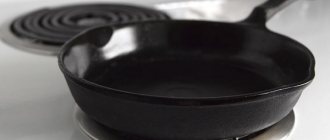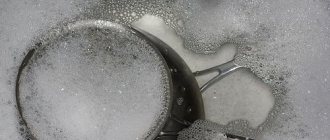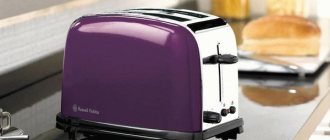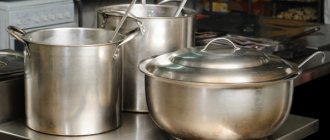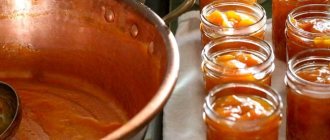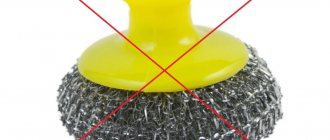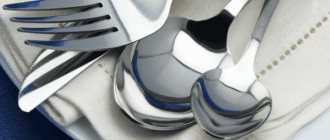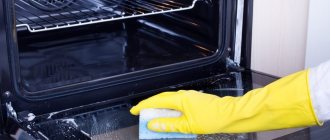Every housewife knows that the kitchen must be perfectly clean, and the dishes in which food is prepared must be washed and free of soot and soot.
Cleaning kitchen utensils is not that difficult or time-consuming if you do it regularly and know how to clean a pot or pan and what products to use to remove grease.
Today in stores you will find many chemical compounds that will help cope with the problem. But you can achieve perfect cleanliness of dishes using simple and cheap products that are found in every home.
How to clean a pan from carbon deposits at home
Before moving on to methods for cleaning cooking containers from carbon deposits, you need to understand what it is.
During the cooking process, it is difficult to avoid splashing of fat, which gets onto the dishes and, under the influence of temperature, is “welded” to the walls of the pans. This plaque is called soot.
How to clean a pan using effective products that are not harmful to health and are safe for coating dishes? Let's consider several ways.
Salt and baking soda
Salt and soda are the best helpers for severe stains.
If the inner surfaces of the dishes are covered with a dense layer of carbon deposits, you can deal with the problem as follows:
- Combine equal amounts of salt and soda.
- Cover the bottom of the pan with the resulting powder so that there are no gaps left.
- Add a small amount of water to obtain a paste-like mixture.
- Cover the dish with a lid and leave for a day.
- After 24 hours, you need to remove the old mixture and prepare a new one.
- Then pour water into the bowl and boil the cleaning liquid for 25–30 minutes.
- When the surface has cooled, wash it with liquid soap or dish gel.
Related article: Women's nightgown with straps: pattern and sewing master class
Salt and soda will help remove even heavy carbon deposits and deal with old stains of grease and soot.
Salt
Fine table salt will help keep your dishes clean and shiny.
How to clean pots this way? Wet the dishes generously in cold water, and then thoroughly rub the contaminated surface with table salt (it is better to use fine salt).
Leave the container to “sour” for 2–3 hours, after which you need to remove carbon deposits and soot with the hard side of the dish sponge.
Activated carbon
Powder of 5-6 tablets of activated carbon will help get rid of burning.
This remedy is indispensable for severely burnt food or milk. How to remove stains and clean the pan from burning using this product? Prepare the powder from 5-6 tablets and scatter evenly over the bottom of the container.
After 30–40 minutes, pour warm water into the bowl and leave for an hour. After carbon deposits and grease stains, you can wash them off with a foam sponge.
Soap solution
This cleaning method is suitable for aluminum and enamel cookware, as well as stainless steel pans.
Fill the container with water, pour in a small amount of soap or dishwashing gel and boil for 20–25 minutes. As a result, the fat will dissolve, and you only need to wash the dishes with a foam sponge to remove any remaining carbon deposits and soot. This method will be effective for small contaminations. If the pan is covered with fat residue on most of the surface, it is better to use other means.
Milk serum
Due to the acid content, this product will help clean off heavy carbon deposits and remove traces of soot. You need to pour the whey into the pan so that the liquid covers the burnt areas by 1.5–2 cm, and leave for a day. After this, you can easily remove any remaining dirt using a foam sponge and detergent.
What not to do when cleaning dishes?
Do not immediately pour water into a hot, burnt pan. In addition to harm to any coating or cast iron and ceramics, such an action can lead to burns from steam or splashes of heated water, hot oil, etc. The dishes need to be cooled, and then immediately begin soaking or cleaning.
It is not recommended to scrape off plaque and carbon deposits with a knife. A metal object leaves deep scratches on aluminum, enamel, cast iron. This cleaning method can completely ruin Teflon dishes. Hard sponges can only be used on abrasive-resistant surfaces (stainless steel, glass and ceramics, cast iron).
Do not clean dishes with chemicals not intended for cleaning food containers. Some substances suitable for cleaning ovens and stoves contain aggressive acids. Using them to clean dishes can be hazardous to health.
How to clean the outside of a pan
Whiteness perfectly cleans the outside of dishes.
Special “cleaners” are not always affordable, and if you do not want to spend money on this purchase, “Whiteness” will help tidy up the outer surface of the dishes. You need to do the following:
- Dilute the chemical in a large container with water.
- Place dirty dishes inside and leave for 24 hours.
- Clean the surface with the hard side of the sponge.
- Rinse the pan in plenty of running water.
- If necessary, repeat the “soaking” process.
If the kitchen utensil is heavily soiled, you can boil it in a large container for 40–45 minutes, adding “Whiteness” to the water.
Caring for dishes and preventing burning
- Start cooking by setting the timer on the stove.
- There is no timer - set a reminder on your phone.
- Wash kitchen utensils regularly and without delay.
- Do not use a dishwashing machine or hard brushes.
- After washing, wipe dry with something.
- Temper the enamel before use (boil water in a new pan)
- Do not cook food in scratched items.
If you use pots correctly, clean them on time and store them properly, then modern housewives can pass them on to future generations.
In general, the choice of method for cleaning a pan from soot and burnt food is determined by the properties of its metal, enamel coating, the presence of available chemical reagents, allergies to them, and the extent of contamination of the pan.
In order for the dishes to be used for a long time, while maintaining a decent appearance, there is a main rule - any dirt must be removed immediately.
How to boil pots at home
You can boil pots not only with “Belizna”; there are also less aggressive compositions. If regular cleaning does not bring the desired results, use one of the boiling methods below.
Salt
To make a solution in a large container you will need 1 pack of salt. Place dirty dishes into the resulting solution and boil for 1.5–2 hours.
Monitor the water level during the boiling process. The dishes should be completely covered with the solution, and you will need to add liquid periodically. When the solution has cooled, remove the pan from the container and clean it as usual.
Baking soda
Using a similar method, you can clean grease stains and soot from a pan by using baking soda.
To make the product, use 1⁄2 packs of soda per 5 liters of water and boil the damaged dishes in the same way as with table salt.
Alkaline soap and PVA glue
This method is safe for all types of pans, no matter what material they are made of. With soap and glue, you can clean even the most heavily soiled dishes.
Prepare a solution (1⁄2 bar of grated laundry soap, 2 tablespoons of PVA glue per 5 liters of water) and boil the dishes in the resulting solution for 40–50 minutes.
When the solution has cooled, you can easily remove carbon deposits from the surface with a regular foam sponge.
Baking soda with silicate glue
These products will help restore your pots to a decent appearance both outside and inside. Cleaning is carried out as follows:
- A large container is filled with water.
- Add 1⁄2 packs of baking soda and a whole tube of silicate glue.
- Bring the solution to a boil and place the soiled pan in it.
Article on the topic: Master class on three-dimensional bead weaving of Baroque beads
After 15–20 minutes, the dishes are removed from the solution and washed in warm water using laundry soap or gel.
Cleaning Features of Non-Stick Coating
In order to clean such a pan, you should use only gentle methods. The use of folk remedies is encouraged, since they are more environmentally friendly and safer for Teflon:
- laundry soap;
- soda;
- salt;
- PVA glue.
When cooking, it is recommended to use spatulas made of plastic, silicone or wood.
To prevent the formation of carbon deposits, it is important to wash the dishes every time after use, otherwise the frozen fat will settle tightly on the surface and may burn during subsequent use. Before you clean the pan from carbon deposits, it is important to understand what material it is made of. Metals react differently to cleaning compounds, and dishes can be damaged beyond repair. A burnt pan can be cleaned with both professional household chemicals and solutions prepared at home.
How to descale a pan at home
When water boils, a white-yellow coating appears on the walls of the dishes, which is not easy to remove without special means. These formations are called scale or limescale, and acid-containing compounds are needed to combat the problem.
How to remove scale quickly so that you don’t have to clean the pan until you are exhausted? In addition to store-bought products, you can use the following cleaning methods.
Sour apples or rhubarb
A natural remedy to combat scale is apples and rhubarb.
Many housewives use the following method: boil sour apples or rhubarb in a contaminated container for half an hour.
Under the influence of acid and high temperatures, the scale dissolves, and after boiling, all that remains is to rinse the container under running water and remove any remaining dirt with a sponge.
Table vinegar
Moisten areas covered with scale with plenty of vinegar and leave the container for 2 hours. Afterwards, wash off the plaque under running water using dishwashing detergent.
You can replace vinegar with citric acid, covering the stains with it, or rub problem areas with a slice of lemon.
To combat scale on the internal surfaces of dishes, you should not use aggressive chemicals - this can lead to severe poisoning.
Cleaning pots made of different materials
The cleaning method directly depends on the material used to make the dishes. Cast iron pans are the most durable; they can be scrubbed with hard sponges and scraped with a knife. Other types of containers require more delicate cleaning.
Enameled
Enamel is a durable material, but must be handled with care. Under no circumstances should you use:
- abrasives;
- metal brushes and sponges;
- other crude devices.
The burnt bottom of an enamel pan can be cleaned using both household chemicals and effective folk remedies:
- Soda. 5 tbsp. l. powder is poured with hot water and mixed. The solution is poured into a dirty container. To remove dark deposits and food residues, the dishes should be left overnight and then cleaned as usual.
- Sour apples. The contaminated surface is rubbed with an apple slice and left for a while. Then the pan is washed under the tap.
Tips for the correct use of enamel pans:
- make only liquid dishes and drinks in them;
- do not cook porridge or roast, which will definitely burn;
- Sudden temperature changes should not be allowed;
- You need to place a container filled with liquid on the fire, but not empty.
Important! Do not try to remove carbon deposits with sharp objects (fork, knife). This can permanently damage the coating.
Stainless steel
Rules for using stainless steel cookware:
- do not leave dirty, wash every time after use;
- It is better not to use a dishwasher;
- to avoid the appearance of stains on the surface after washing, you need to wipe the pan dry;
- Do not use hard tools for cleaning as they can scratch the dishes.
Ways to deal with soot:
We recommend:
DIY clothes dryer
- Soap solution. This method will only remove fresh dirt. Soap shavings or a small amount of dishwashing detergent are dissolved in water, and the mixture is poured into a container. After several hours, the carbon deposits can be easily removed with a sponge.
- Coca Cola. The drink is poured into a saucepan and brought to a boil. After some time, the liquid is drained, the dishes are washed under running water and wiped dry.
Important! Salt is harmful to stainless steel.
Made of aluminum
The soft alloy absorbs coal particles, as a result, the burnt food sticks tightly to the bottom. Hard brushes and sponges are not suitable for removing carbon deposits from the surface of aluminum. Special chemical compounds and folk remedies will be effective:
- Glue. If the contamination is old and very voluminous, and other means have not helped, this method will help get rid of burnt marks. Several liters of water are boiled in a saucepan, a couple of teaspoons of PVA and grated laundry soap (⅓ of a piece) are poured into it. The pan is tightly closed with a lid, the whole mixture is boiled for a little less than an hour.
- Dishwasher tablet. Water is poured into the pan until it covers the entire burnt area. After adding the tablet, the mixture is brought to a boil and simmered for about half an hour.
Other types
The only cookware that is suitable for mechanical cleaning is cast iron. To do this you will need a knife, a metal sponge and boiling water. To increase efficiency, you can heat the pan to 200 degrees to melt the fat. After cooling, the dishes are immersed in hot soapy water, and all the carbon deposits are scraped off with a knife. Residues are removed with a steel wool.
How to make pots shine
To restore the shine of the dishes, you can rub them with a cut of young potatoes.
To keep the pots shiny and not stained by dry moisture, they must be wiped dry after each wash.
In addition, you can rub the surface with a cut of raw potato or soak it in a weak vinegar solution for 10–15 minutes. The main thing is to thoroughly rinse the dishes after this treatment and remove any remaining moisture with a towel.
By following these recommendations and promptly cleaning the dishes from carbon deposits and soot, you will achieve ideal cleanliness and shine of the pots.
Salt
To clean pans from simple stains, use regular fine salt. There are several cleaning methods:
- A small amount of salt is applied to a damp sponge and the surface is gently wiped until stains and deposits are completely removed, after which the dishes are rinsed with cold water.
- Dilute 6 tablespoons of salt in a liter of warm water and pour the solution into a pan, leaving it in the bowl for 6 hours. For better results, the solution can be heated directly in a saucepan over low heat. After which the dishes should be washed with detergent.
What to pay attention to from modern means
The modern woman has a large supply of detergents. They differ in composition and, accordingly, in action.
Dishwashing liquid: a quick way to clean burnt marks
First of all, you need to use the dishwashing detergent that you use daily at home. For example, Fairy.
It can be used to remove stubborn grease and carbon deposits. Used when soaking.
To achieve a good result, you need to follow the following scheme:
- Fill the heated pan with hot water. Add a few drops of Fairy.
- Leave for at least 1-2 hours.
- After time, drain the water and rub gently with a sponge.
Some stains are not so easy to remove. Then after soaking, you need to fill the pan with water again and add detergent. Place on the stove and boil. Then rub again with a sponge.
Or use an alternative method. Pour the soot liberally over Fary and leave overnight. But it is worth considering that the product must completely cover the stains, otherwise the carbon deposits will dry out in the air. Then there will be no effect.
Cleaning powders will remove burnt-on grease
Pemolux and Comet cleaning powders are designed to quickly combat more severe carbon deposits. They are used in certain areas with contamination that could not be removed by soaking. Any of the means is suitable.
Algorithm of actions:
- Wash the pan.
- Sprinkle cleaning powder onto the stains.
- Rub the carbon deposits with the hard side of the sponge. A metal sponge will not work as it may damage the coating.
- Rinse the pan thoroughly.
Oven cleaners
Used in advanced cases. There are inopportune moments when the pan can get very burnt, in this case it is worth using products such as Shumanit, Cillit, etc. It is worth considering that these products are quite aggressive not only towards burnt dishes, but also to the skin.
They are quite toxic. Therefore, it is necessary to use gloves and thoroughly wash the pan and sink to remove any remaining product.
The method of application depends on the specific product and is described on the packaging.
